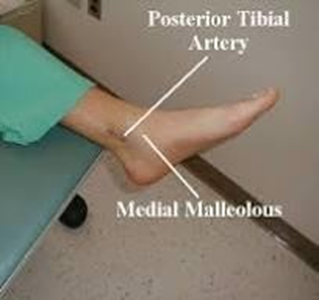A nurse performing an assessment would correctly note that an absent pulse in one or more of the extremities indicates
Decreased plasma volume.
Problems with the heart's electrical conduction system.
Shock.
A blockage of blood flow.
The Correct Answer is D
A. Decreased plasma volume might cause overall weak pulses but would unlikely cause an absent pulse specifically localized in one or more extremities. Decreased plasma volume generally affects circulation systemically, not selectively in certain limbs.
B. Problems with the heart's electrical conduction system primarily affect the rhythm and rate of the heart but do not directly cause absent pulses in extremities. These issues lead to irregular or abnormal heartbeats, not localized absence of pulses.
C. Shock can result in weak or thready pulses due to poor blood flow, but shock alone would not typically cause a pulse to be completely absent in one extremity while present in others. Shock affects the circulatory system as a whole.
D. A blockage of blood flow is the most likely cause of an absent pulse in one or more extremities. This could be due to atherosclerosis, embolism, or thrombosis, which can obstruct blood flow in specific areas, leading to no detectable pulse in those extremities.
Nursing Test Bank
Naxlex Comprehensive Predictor Exams
Related Questions
Correct Answer is D
Explanation
A. Decreased plasma volume might cause overall weak pulses but would unlikely cause an absent pulse specifically localized in one or more extremities. Decreased plasma volume generally affects circulation systemically, not selectively in certain limbs.
B. Problems with the heart's electrical conduction system primarily affect the rhythm and rate of the heart but do not directly cause absent pulses in extremities. These issues lead to irregular or abnormal heartbeats, not localized absence of pulses.
C. Shock can result in weak or thready pulses due to poor blood flow, but shock alone would not typically cause a pulse to be completely absent in one extremity while present in others. Shock affects the circulatory system as a whole.
D. A blockage of blood flow is the most likely cause of an absent pulse in one or more extremities. This could be due to atherosclerosis, embolism, or thrombosis, which can obstruct blood flow in specific areas, leading to no detectable pulse in those extremities.
Correct Answer is C
Explanation
A: This is not suitable for assessing circulation issues specifically in the lower extremities as it is located on the upper body.
B: This is not suitable for assessing circulation issues specifically in the lower extremities as it is located on the upper body.
C: Palpating the posterior tibialis pulse is a logical next step for checking lower extremity circulation, particularly when dorsalis pedis is not palpable, helping localize the evaluation of blood flow in the foot and ankle.
D: The femoral pulse is useful for broader leg circulation issues. However, it is less targeted than posterior tibialis for checking blood flow in the lower extremities.

Whether you are a student looking to ace your exams or a practicing nurse seeking to enhance your expertise , our nursing education contents will empower you with the confidence and competence to make a difference in the lives of patients and become a respected leader in the healthcare field.
Visit Naxlex, invest in your future and unlock endless possibilities with our unparalleled nursing education contents today
Report Wrong Answer on the Current Question
Do you disagree with the answer? If yes, what is your expected answer? Explain.
Kindly be descriptive with the issue you are facing.
